Geochemical characteristics of hadal sediment in the northern Yap Trench*
HUANG Yuhuan , SUN Chengjun , YANG Guipeng , , , YUE Xin’an , JIANG Fenghua CAO Wei YIN Xiaofei GUO Chaonan ,
NIU Jiaohong 1, 3, DING Haibing 1, 4, 5, **
1 Key Laboratory of Marine Chemistry Theory and Technology/Ministry of Education, Ocean University of China, Qingdao 266100, China
2 Key Laboratory of Marine Eco-environmental Science and Technology, Marine Bioresource and Environment Research Center, First Institute of Oceanography, Ministry of Natural Resources, Qingdao 266061, China
3 College of Chemistry and Chemical Engineering, Ocean University of China, Qingdao 266100, China
4 Marine Ecology and Environmental Science Laboratory, Pilot National Laboratory for Marine Science and Technology, Qingdao 266237, China
5 Qingdao Collaborative Innovation Center of Marine Science and Technology, Qingdao 266100, China
6 South China Sea Environment Monitoring Center, State Oceanic Administration, Guangzhou 510300, China
Received Jan. 17, 2019; accepted in principle Mar. 25, 2019; accepted for publication Jul. 3, 2019 © Chinese Society for Oceanology and Limnology, Science Press and Springer-Verlag GmbH Germany, part of Springer Nature 2020
Abstract Two sediment cores were retrieved in the hadal zone of the Yap Trench, and their concentrations of six major elements Mg, Al, Ca, Ti, Mn and Fe and nine trace elements Sr, Ba, Pb, V, Cr, Co, Ni, Cu and Zn were determined in inductively coupled plasma atomic emission spectrometry (ICP-AES). According to the vertical distribution profi les of the 15 elements, the correlation of their concentrations, the ratios of Ni/Co, V/Cr, Fe/Al, and Ti/Al, and morphological characteristics of the sediment samples, the implications of the depositional environment and the sediment provenance were analyzed. The results show that the ratio of Ni/Co in all depths of the two sediment cores were below 5, and the ratio of V/Cr were lower than 2, indicating that the depositional environment of the hadal zone in the trench was oxidative and might have infl ow of the Antarctic bottom oxygen-rich water. The sediment samples on the eastern side of the trench were siliceous mud mainly composed of diatoms, radiolarian, and sponge needles from surface to deep layer. The vertical profi le of the elements, the concentration of TOC and the fossil record indicated that the sediment sample from station Dive113 was well mixed from surface to bottom layer. Based on the correlation of concentrations of the elements, the morphological characteristics of the sediment, and the ratios of Fe/Al and Ti/Al, we inferred that the sediment in the hadal zone of the trench had terrestrial, volcanic, biological, and authigenic sources. Major source of the sediment in the eastern side of the trench were terrestrial; whereas the sediment in the western side of the trench received more volcaniclastic input.
Keyword: Yap Trench; hadal zone; Jiaolong Submersible; sediment metal elements; sedimentary environment
1 INTRODUCTION
Hadal zone located 6 000 m below sea level represents the deepest region of the earth’s biosphere and is the least known ecosystem in the world (Watling et al., 2013; Turnewitsch et al., 2014). Due to the limitation of technology in deep-sea survey, the hadal zone was once considered as an “ecological desert” for a long time. Until recent decades, with the improvement of deep-sea technology, especially deep-dive technology, hadal science has obtained increasing attention from worldwide and become an international hot spot for deep-sea research (Luo et al., 2017). Hadal trenches represent the submarine subduction factory, extreme environment, hydrostatic pressure, and high level of species endemism (Jamieson et al., 2010; Jamieson, 2011). Studying hadal trench is critical for realizing hadal environment.
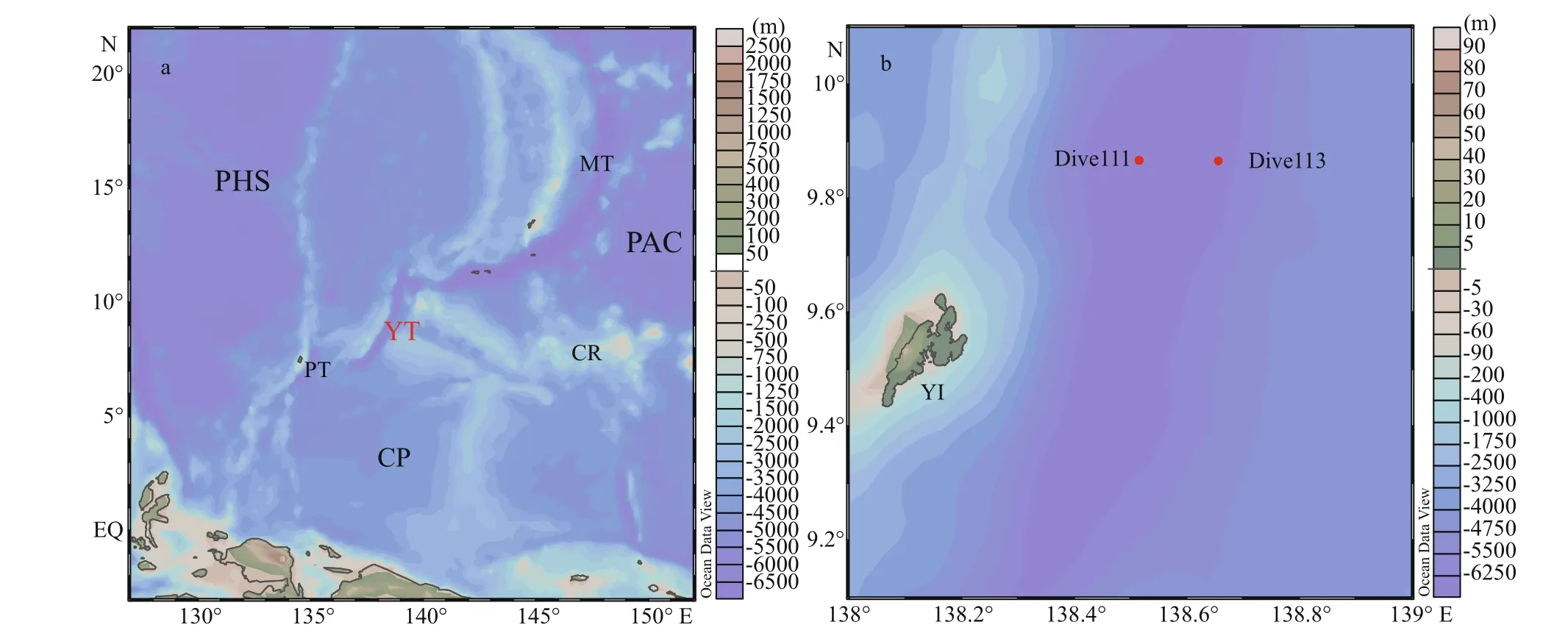
Fig.1 Geographic information (a) and sampling stations (b) of the research area
A couple of exploration and investigation on geochemical characteristics of hadal sediment have been conducted recently. For example, Luo et al. (2017) investigated the provenances, distribution, and accumulation of organic matter in sediment at the Southern Challenger Deep. In addition, deposition environment, sediment dynamics, and microbial activity of sediments in the Challenger Deep were also documented (Luo et al., 2018b). Benthic carbon mineralization in sediment at hadal trenches was reported by Luo et al. (2018c) and Wenzhöfer et al. (2016). In fact, surface sediment in hadal zone is considered as the most important benthic environment providing habitat and energy for hadal organisms (Glud et al., 2013). Studying the geochemical characteristics of hadal sediments, including their composition, provenance, sedimentation, heavy metal contamination etc., is important to understand the feature of benthic environment in the hadal zone (Ramos-Vazquez et al., 2017, 2018).
The Yap Trench is located at the junction of the Philippine Sea Plate, the Pacifi c Plate, and the Caroline Plate, adjacent to the Mariana Trench in the north, the Palau Trench in the southwest, and the Caroline Ridge in the east. The deepest point of the Yap Trench is 8 527 m. It has been reported as a typical hadal zone with low-temperature fl uids and cold spring biomes, and a large number of unique species, forming an ideal area to study the adaptation mechanisms and biological processes of organisms in extreme environments (Zhang et al., 2018). Most previous researches focused on its rock composition, water fl ow, geological structure, and ecology (Hawkins and Batiza, 1977; Johnson and Toole, 1993; Fujiwara et al., 2000; Song et al., 2016). Few studies were conducted on the detailed geochemical characteristics of its sediment due to the diき culty for collecting samples. In this study, geochemical characteristics of two hadal push cores retrieved by the manned Jiaolong Submersible in the trench were investigated. Concentrations of six major and nine trace elements were measured and surface morphology of the sediment samples was observed to elucidate sediment provenance and depositional environment. This research is helpful for further understanding of sedimentary geochemical characteristics in hadal zones.
2 MATERIAL AND METHOD
2.1 Sample collection
In May 2016, R/V Xiangyanghong 09 carried the deep-sea manned Jiaolong Submersible and conducted No.37 Cruise. Two push cores from Dive113 station (138°39.41′E, 9°51.93′N, 6 578 m) and Dive111 station (138°30.94′E, 9°52.06′N, 6 779 m) were retrieved by the submersible in the northern Yap Trench. Dive113 station is located in the eastern side of the Yap Trench; and Dive111 station is located in the western side of the trench. The geographic information and the location of the sampling stations of the research area are shown in Fig.1. Upon retrieval, the collected cores were sliced immediately at 1 cm intervals on deck and well-mixed. Each sliced sediment sample were separated into two fraction. One fraction was placed in a sealed bag, and the other fraction was packed in aluminum foil. All the samples were frozen at -20°C for future analysis.
2.2 Analytical methods
2.2.1 Water content
About 5 g wet sediment was freeze-dried in a 1-4LDPLUS vacuum freeze dryer (Germany Christ Gmbh) and maintaining 48 h to make the sample weight constantly and then calculated the water content based on the weight difference erence before and after drying. The dried sediment samples were divided into two fractions. One fraction (about 100 mg) was screened through 100-mesh plastic sieve for metal element analysis, and the other fraction was screened through 100-mesh steel sieve for TOC measurement and scanning electron microscopy (SEM) observation.
2.2.2 Total organic carbon (TOC)
TOC was determined by a combination of pickling in situ method (Peng et al., 2015) and an elemental analyzer. The brief steps were as followed: 100 mg of the sediment sample in packed aluminum foil which was screened through the 100-mesh steel sieve was transferred into a glass centrifuge tube, and then dropped into dilute hydrochloric acid (V hydrochloric acid: V water=1:5, Sinopharm Group Chemical Reagent Company, guarantee reagent) until no more bubbles in the tube or the powder was completely submerged by the liquid. After gently shaking the tube to make the reaction completely, the sediment sample was dried in a blast-drying oven at 60°C for 24 h. The dried sediment was removed from the oven and placed on table until its weight was constant, then gently grinded into powder and wrapped in aluminum foil, which had been combusted at 450°C for 6 h, and then stored in dryer for further analysis. About 10-30 mg of the powder sample was transferred into a tin cup. The TOC concentration was measured by an EA2000 elemental analyzer (American Thermo Fisher Scientifi c). Since the powder weight changed slightly before and after the removal of inorganic carbon, the concentration of TOC need to be corrected by the weight factor. The formula is as follows:

where ωTOC: TOC content of the sediment sample (%); m: the sediment weight (g); m′: weight of removal of inorganic carbon deposits (g); ω: TOC content directly measured by elemental analyzer (%)
2.2.3 Analysis of major and trace elements
The concentrations of various elements in the sediment samples were determined by inductively coupled plasma atomic emission spectrometry (ICPAES) (Hettipathirana and Lowenstern, 2015). All the fi fteen samples were processed at the same time according to the following steps: 100 mg of the grinded sediment sample in sealed bag was screened through a 100 mesh plastic sieve and then transferred into a MDS-6G multi-fl ux closed microwave instrument (Shanghai Xinyi Weibo Chemical Technology Co. Ltd.). After that, about 5 mL of nitric acid (HNO3), 2 mL of perchloric acid (HClO4) and 2 mL of hydrofl uoric acid (HF) were added to the sample. The temperature gradient was set to increase at 10°C/min to 200°C and hold for 10 min. After the sample cooling, 2 mL of hydrochloric acid (HCl) was added and then heated on a hot plate. According to the state of digestion, appropriate amount of HF was added until the digestion was completed. The solution was evaporated to less than 1 mL and cooled to form white crystals. The crystals were dissolved in HNO3solution (V nitric acid׃V water=1׃7) and dilute to 10 mL. HNO3, HClO4, HF, and HCl were obtained from the Sinopharm Group Chemical Reagent Company. The concentrations of various elements were determined by an ICAP-6300 plasma emission spectrometer (British Thermo Fisher). The element standards were multi-metal element mixed solution (GSB 04-1767-2004, National Nonferrous Metals and Electronic Materials Analysis and Testing Center) and calcium ion single standard solution (GSB 04-1720-2004, National Iron and Steel Materials Testing Center, Central Iron and Steel Research Institute).
2.2.4 Scanning electron microscopic observation
The sediment samples were placed on a lead block. After purging, vacuuming, and gold spraying, the morphology of the sediment was observed in a high vacuum mode using a Quanta 200 environmental scanning electron microscope (Dutch FEI Company). The acceleration voltage was 20 kV, and a suitable magnifi cation pair was selected to scan multiple fi elds. After saving the images, the species can be identifi ed according to the shape of fossils in the sediment (Luo et al., 2018b). For special fossils, we use energy dispersive spectrometer (EDS) to determine its composition.
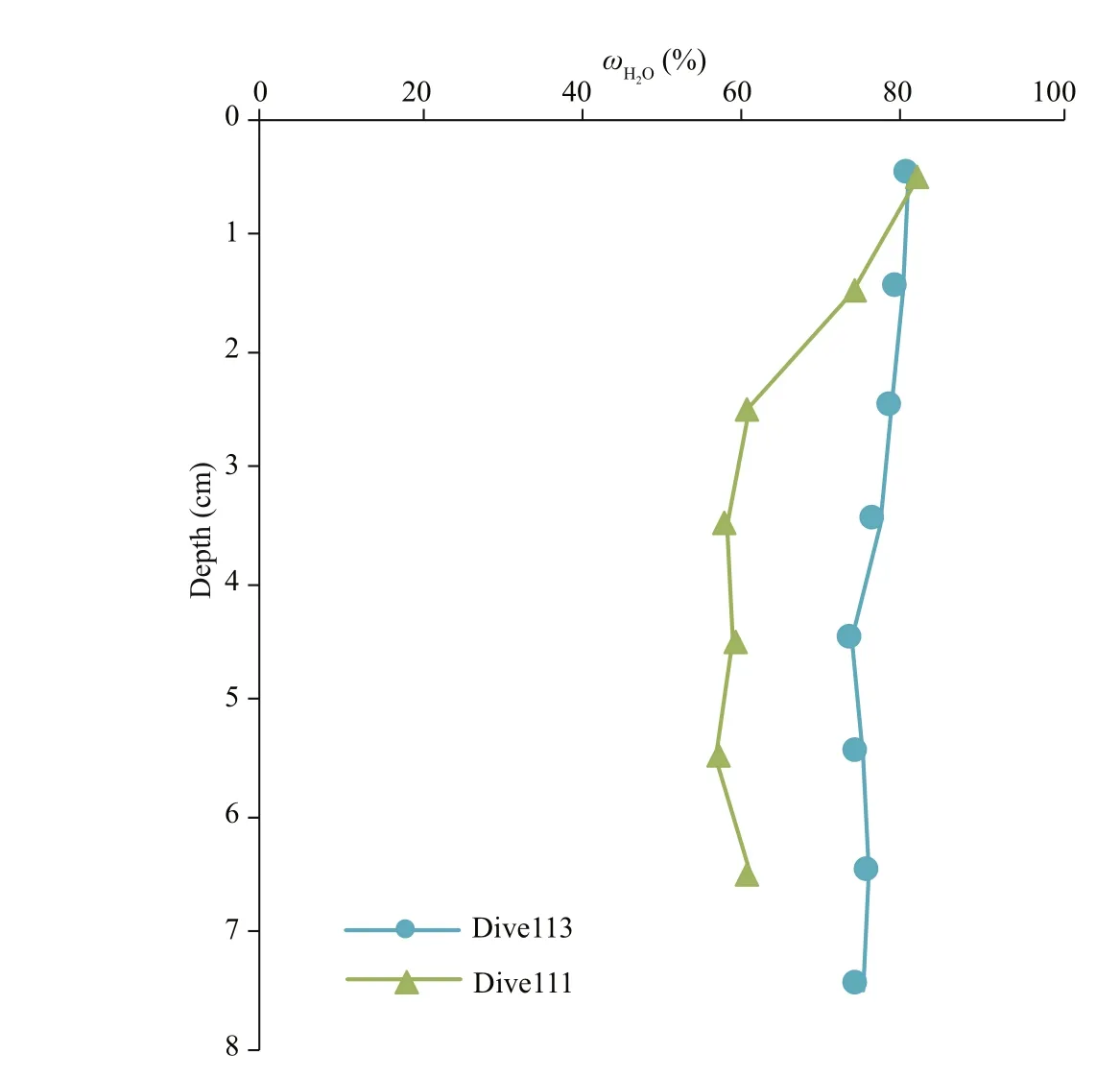
Fig.2 Vertical variation profi les of the water content in the two sediment samples from the Dive113 and Dive111 stations in the Yap Trench
3 RESULT
3.1 Water content
Water content of the sediment sample (0-8 cm) in Dive113 station ranged from 74% to 81%, with an average of 77%±3%. Water content of the sediment sample (0-7 cm) in Dive 111 station fl uctuated from 57% to 82%, with a mean value 64%±10%. Vertical variation profi les of the water content in the two sediment samples are shown in Fig.2. Water content in the sediment sample from Dive113 station remained relatively constant with depth. The difference erence between the maximum value (in 0-1 cm layer) and minimum value (in 4-5 cm layer) was only 7%. At Dive111 station, the water content of the sediment sample decreased remarkably with depth, with maximum value at 0-1 cm layer and minimum value at 5-6 cm layer. The highest water content appeared in surface sediment layers of both samples. Below the surface sediment, water content in the sediment sample from Dive113 station was higher than those from Dive111 station in all layers.
3.2 TOC concentrations
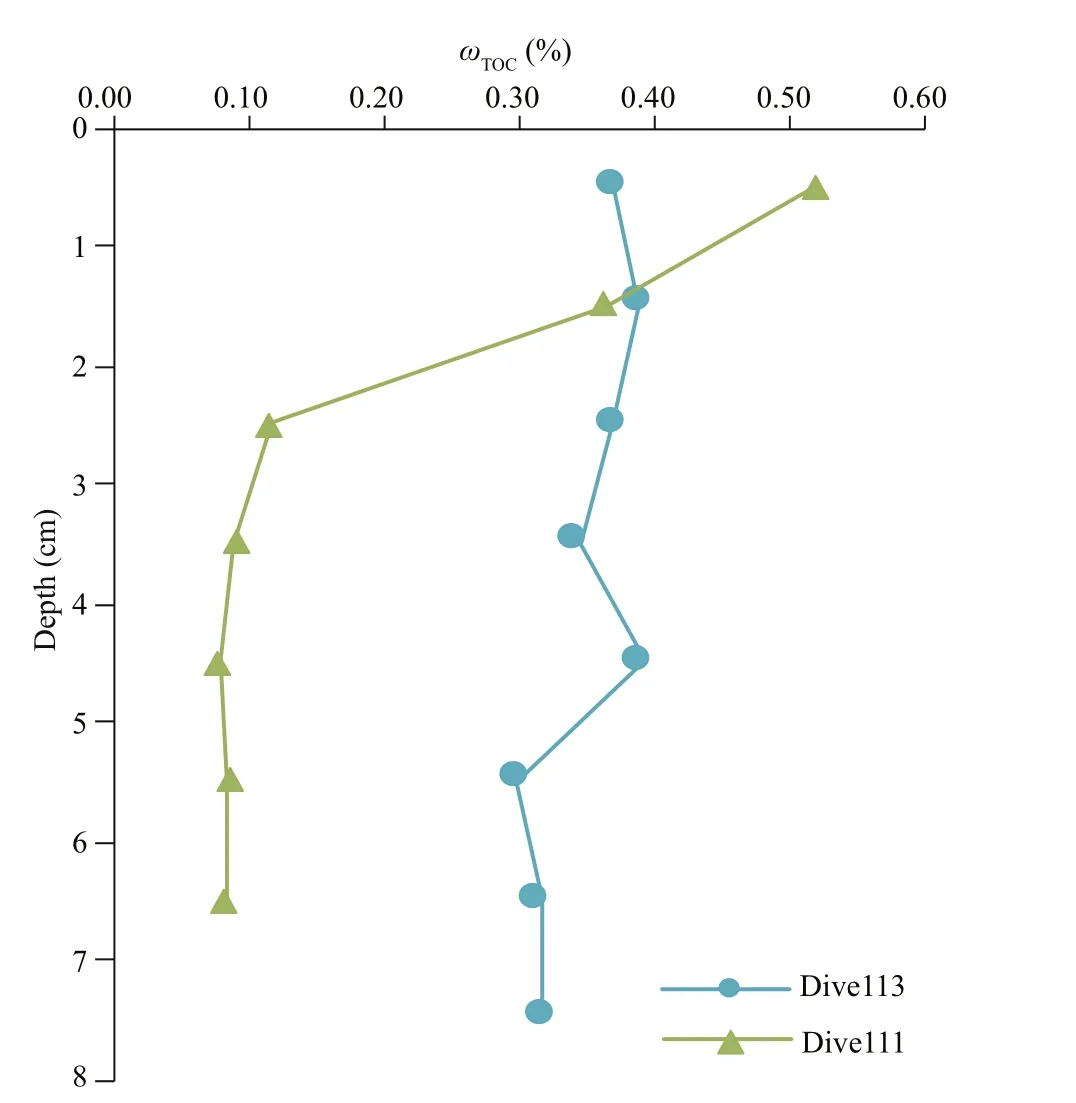
Fig.3 Vertical variation profi les of TOC in the two sediment samples from Dive113 and Dive111 stations in the Yap Trench
The concentrations of TOC in the sediment samples from Dive113 station (0-8 cm) ranged from 0.30% to 0.39%, with a mean of 0.35%±0.02%. In Dive111 station, the concentrations ranged from 0.08% to 0.52%, with an average of 0.19%±0.18%. The vertical variation profi les of concentrations of TOC in the sediment samples are shown in Fig.3. The concentration of TOC in the sediment from Dive113 station had little change with depth. The maximum concentration appeared in 1-2 cm and 4-5 cm layers, and the minimum concentration appeared in 5-6 cm layer. In Dive111 station, the concentrations of TOC decreased rapidly from 0-3 cm sediment layers, and then remained relatively constant. The vertical variation trends of water content and concentrations of TOC were similar. The maximum concentration of TOC appeared in 0-1 cm layer in both sediment samples. The minimum concentrations of TOC appeared in 5-6 cm layer in the sample from Dive113 station and 6-7 cm layer in the sample from Dive111 station. Except the surface layer, the concentrations of TOC in all sediment layers in Dive113 station were higher than those in Dive111 station.
3.3 Element concentrations
In this study, the concentrations of six major metal elements and nine trace metal elements in the two sediment samples were determined and shown in Supplementary Tables S1 and S2. Vertical variation profi les and histograms of concentrations of six major metal elements are in Figs.4 & 5. The profi les and histograms of concentrations of nine trace metal elements are in Figs.6 & 7.
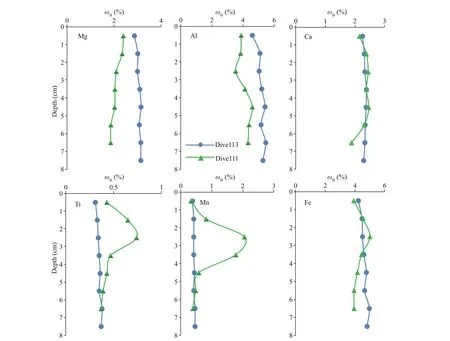
Fig.4 Vertical variation profi les of concentrations ( ω B, %) of six major elements in two sediment samples from the Yap Trench
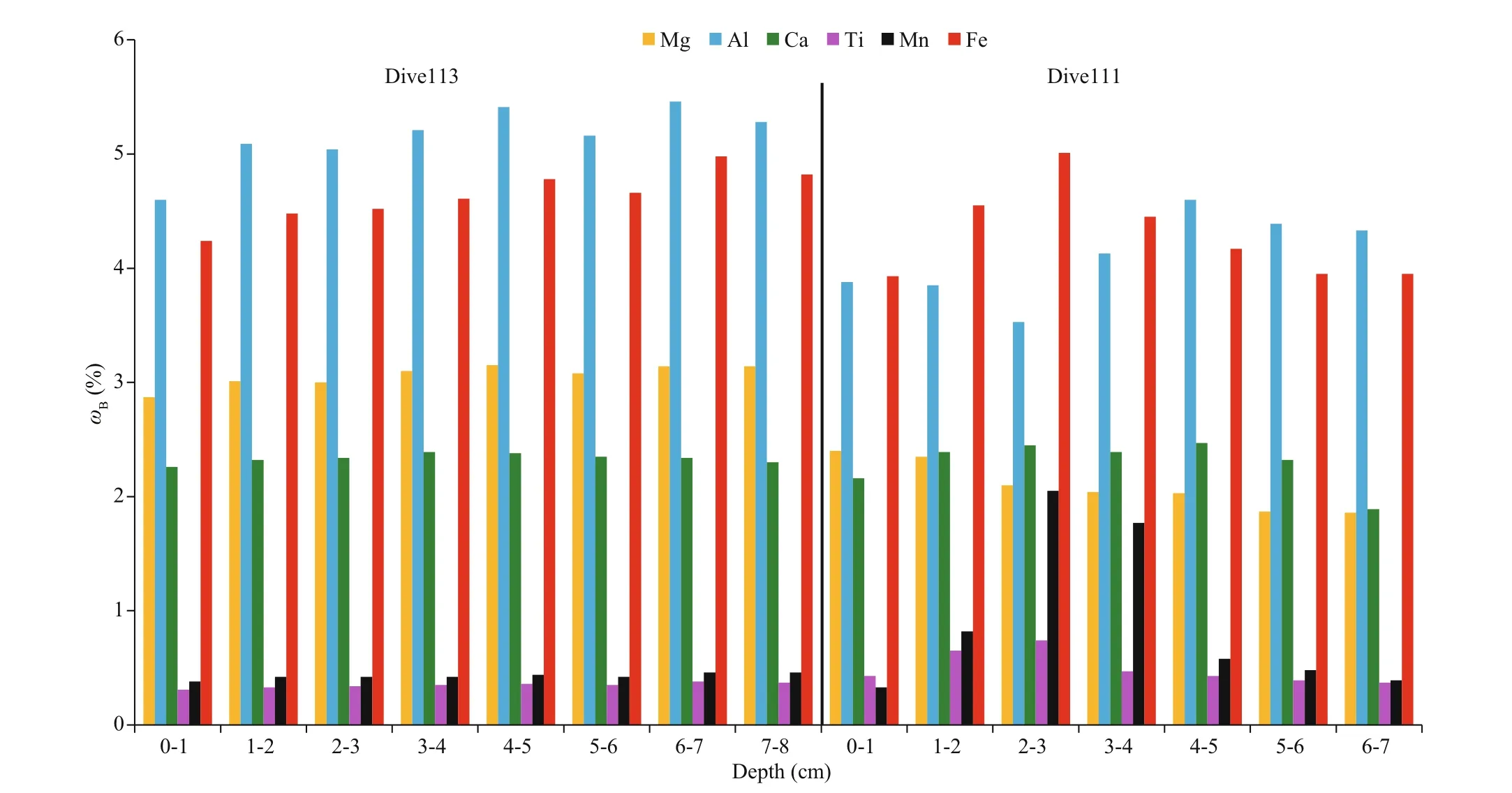
Fig.5 Histogram of concentrations of six major elements in two sediment samples from the Yap Trench
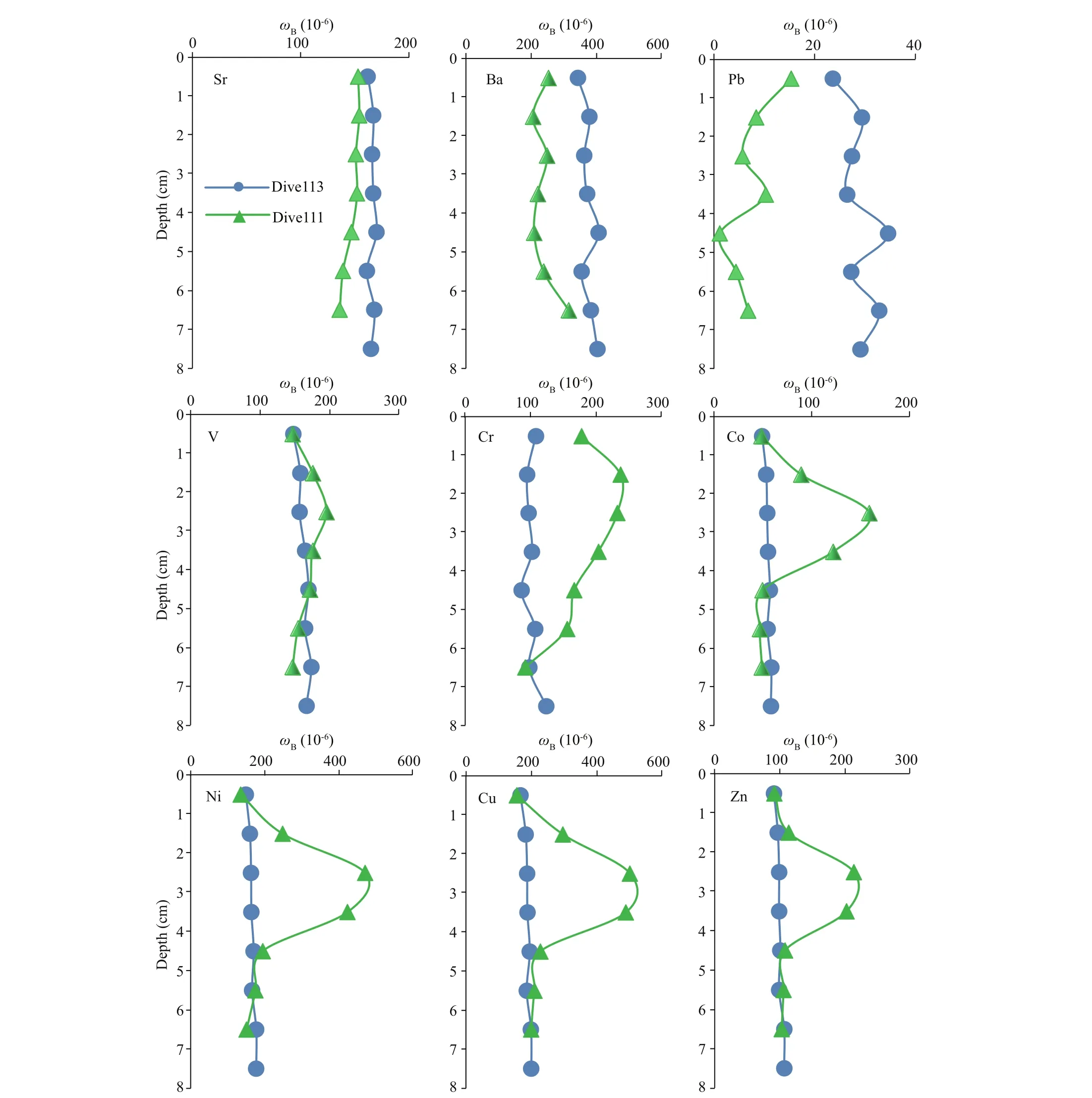
Fig.6 Vertical variation profi les of concentrations ( ω B, 10-6) of nine trace elements in two sediment samples from the Yap Trench
The maximum and minimum concentrations of Mg, Al, Ca, Ti, Mn, Fe in Dive113 and Dive111 stations are listed in Table 1. As shown in Figs.4 & 5, the concentration of each element in the sediment sample from Dive113 station had little change with depth. As a comparison, the concentration of each element in the sediment sample from Dive111 station varied signifi cantly with depth. In the sediment sample, the maximum concentrations of the major elements almost appeared in 2-3 cm and 4-5 cm depths (Figs.4 & 5), and their minimum concentrations appeared in 0-1 cm and 6-7 cm in general. In the 2-3 cm layer, the concentrations of Ti, Mn, and Fe were signifi cantly higher, up to 0.74%, 2.05%, and 5.01%, respectively.
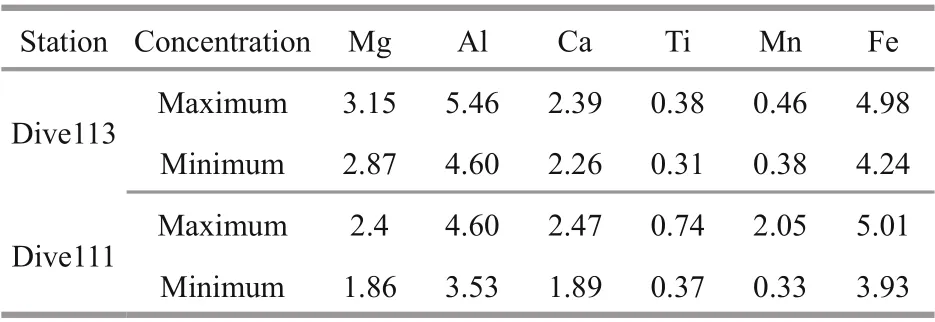
Table 1 The maximum and minimum concentrations ( ω B, %) of the six major elements in two sediment samples from the Yap Trench

Table 2 The maximum and minimum concentrations ( ω B, 10 -6) of nine trace elements in two sediment samples from the Yap Trench

Fig.7 Histogram of concentrations of nine trace elements in two sediment samples from the Yap Trench
The maximum and minimum concentrations of Sr, Ba, Pb, V, Cr, Co, Ni, Cu, and Zn in two sediment samples are shown in Table 2. As shown in Figs.6 & 7, the concentration of each element in the samples from Dive113 station varied insignifi cantly with depth, and their concentrations in Dive111 station varied remarkably with depth. In Dive111 station, the maximum concentrations of most of the trace elements appeared in 2-3 cm, and their minimum concentrations appeared in 0-1 cm and 6-7 cm depths, similar as the major elements. The concentration of V, Co, Ni, Cu, Zn at 2-3 cm was signifi cantly higher, up to 196×10-6, 159×10-6, 472×10-6, 502×10-6, 214×10-6, respectively.
As shown in Figs.4 & 5, concentrations of Mg and Al in the sediment from Dive111 station were lower than those from Dive113 station. In 1-4 cm layers, concentrations of Ti, Mn, and Fe in Dive111 station were higher than those from station Dive113. For trace elements, as shown in Figs.6 & 7, the concentration of Pb in Dive111 station was lower than that from Dive113 station. Moreover, high concentrations of Cr, Co, Ni, Cu, and Zn occurred in the 1-4 cm layers from Dive111 station. There were a large number of black manganese nodules in the sediment samples from Dive111 station. Major compositions in the manganese nodules are oxides and hydroxides of Fe and Mn. The elements Co, Cu, Ti, Ni, etc. are also enriched in the manganese nodule.
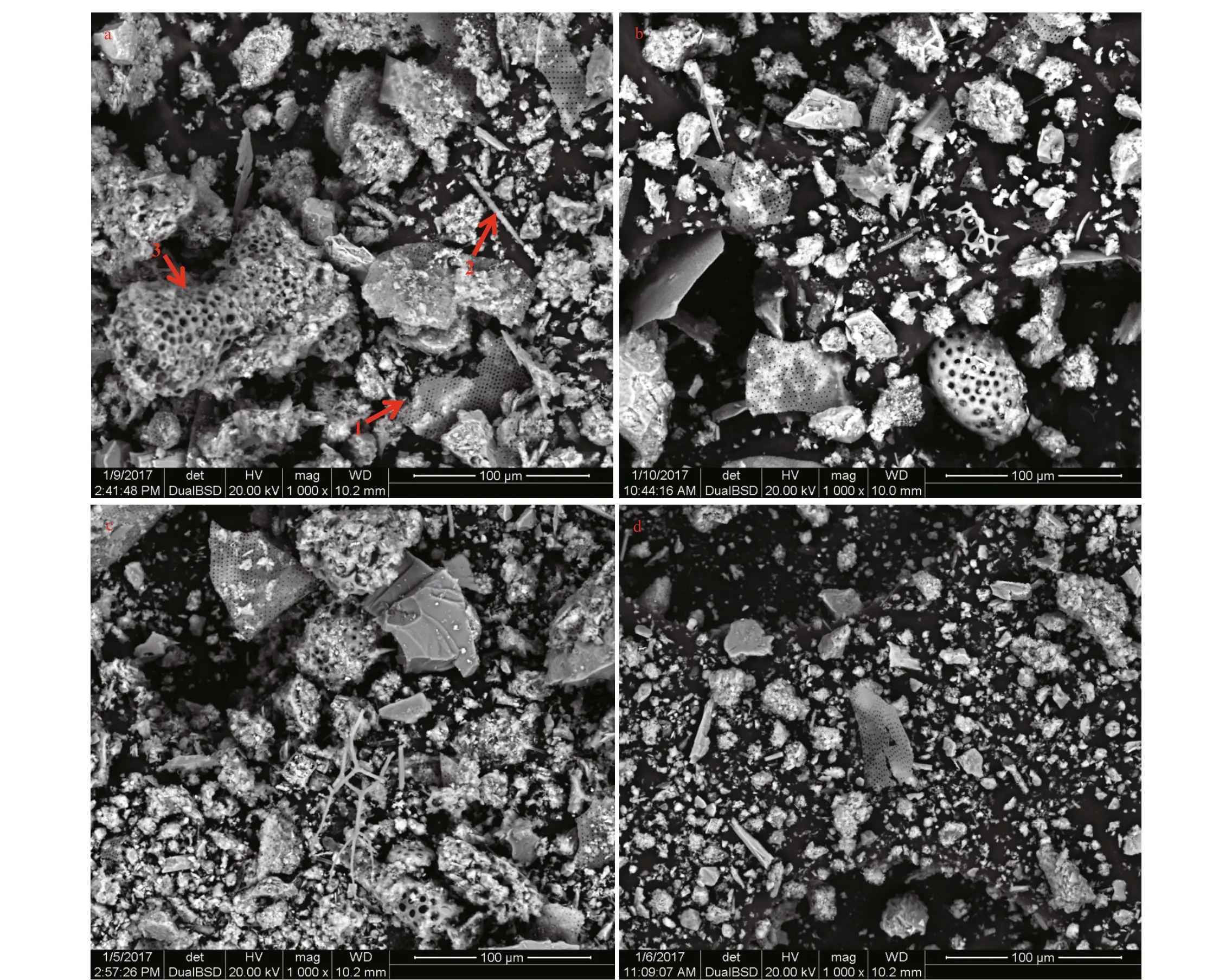
Fig.8 Images of scanning electron microscope of surface (a & c) and bottom (b & d) sediments from Dive113 (a & b) and Dive111 (c & d) stations in the Yap Trench
3.4 Images of scanning electron microscope
As shown in Fig.8, the sediment sample from Dive113 and Dive111 station were siliceous mud. In Dive113 station, many fossil remains of diatoms, radiolarians, and sponge needles were detected from surface to bottom of the samples. A typical diatoms species in the sample was Ethmodiscus rex. The radiolarians were mainly cage-shaped and spherical. Most of the sponge bone needles were uniaxial and quadrilateral. In Dive111 station, fossil remains of diatoms, radiolarians, and sponge bone needles were rich in surface sediment, and gradually decreased with depth.
4 DISCUSSION
4.1 Siliceous sediment and bottom fl ow of the hadal zone in the Yap Trench
The average concentration of Al in the two sediment samples from Dive113 and Dive111 stations was 5.16%±0.27% and 4.10%±0.37%, respectively. The average concentration of Al in the deep-sea sediment of the Pacifi c Ocean was 8.79% (Bischofference et al., 1979), so the depositional environment of the Yap Trench was not a typical deep-sea clay deposit. Shen et al. measured the concentration of calcium carbonate in the sediment of the Central Pacifi c Basin (7°N-12°N, 166°W-178°W) and found that the carbonate compensation depth (CCD) line was around 5 200 m (Bischofference et al., 1979), so the Yap Trench with water depth larger than 6 500 m should contain negligible carbonate. As shown by SEM observation, biological fragments composed mainly of E. rex fragments, radiolarian, sponge bones, and other siliceous biological debris (Fig.8). Large amount of E. rex fragments further formed giant diatom mats. In the southern Challenger Deep (Mariana Trench), Ethmodiscus rex was also a typical diatom species, which could be forming giant diatom mats (Luo et al., 2018a, b). Previous study showed that at the bottom of diatom mats, a remarkable strengthened eolian deposition was recorded. Based on Si isotope composition of E. rex in laminated diatom mats (LDMs), the eolian deposition stimulated Ethmodiscus rex blooms by increasing the supply of nutrients such as Si and Fe in oligotrophic surface waters of the Philippine Sea (Xiong et al., 2015). Recently, Luo et al. (2018b) proved that eolian dust inputs from the Central Asian deserts stimulated E. rex blooms and formation of LDMs in the northwestern tropical Pacifi c Ocean. The Yap Trench is close to these areas and afference ected by Asian dust inputs. The formation mechanism of the large quantity of diatom fossils in the study area of the Yap Trench maybe related with formation of LDMs in the northwestern tropical Pacifi c Ocean. The concentrations of the fi fteen elements in the sediment samples from Dive113 station varied insignifi cantly with depth. Water content and TOC content in the sediment sample from Dive113 station also did not change signifi cantly with sediment depth. The fossils of sediment samples in the Dive113 station were siliceous mud mainly composed of diatoms, radiolarian, and sponge bones in each sediment layer. The vertical profi le of the elements, the concentration of TOC and the fossil record indicated that the sediment sample from Dive113 station was well mixed from surface to bottom layer. In marine environment, many processes might afference ect erosion, transport, deposition, resuspension and etc., of sediment at sedimentseawater interface, such as bottom current, turbidite fl ows, earthquakes and etc. (Dubois and Mitchell, 2012; Juan et al., 2018; Paull et al., 2018). Although recently study showed that the bottom fl ow in the Yap Trench was mainly composed of low frequency motions, near inertial motions, diurnal motions, semidiurnal motions and geostrophic circulation (Liu et al., 2018). However, more studies are necessary to investigate the mechanism for mixing the surface sediment in the hadal zone of the Yap Trench.
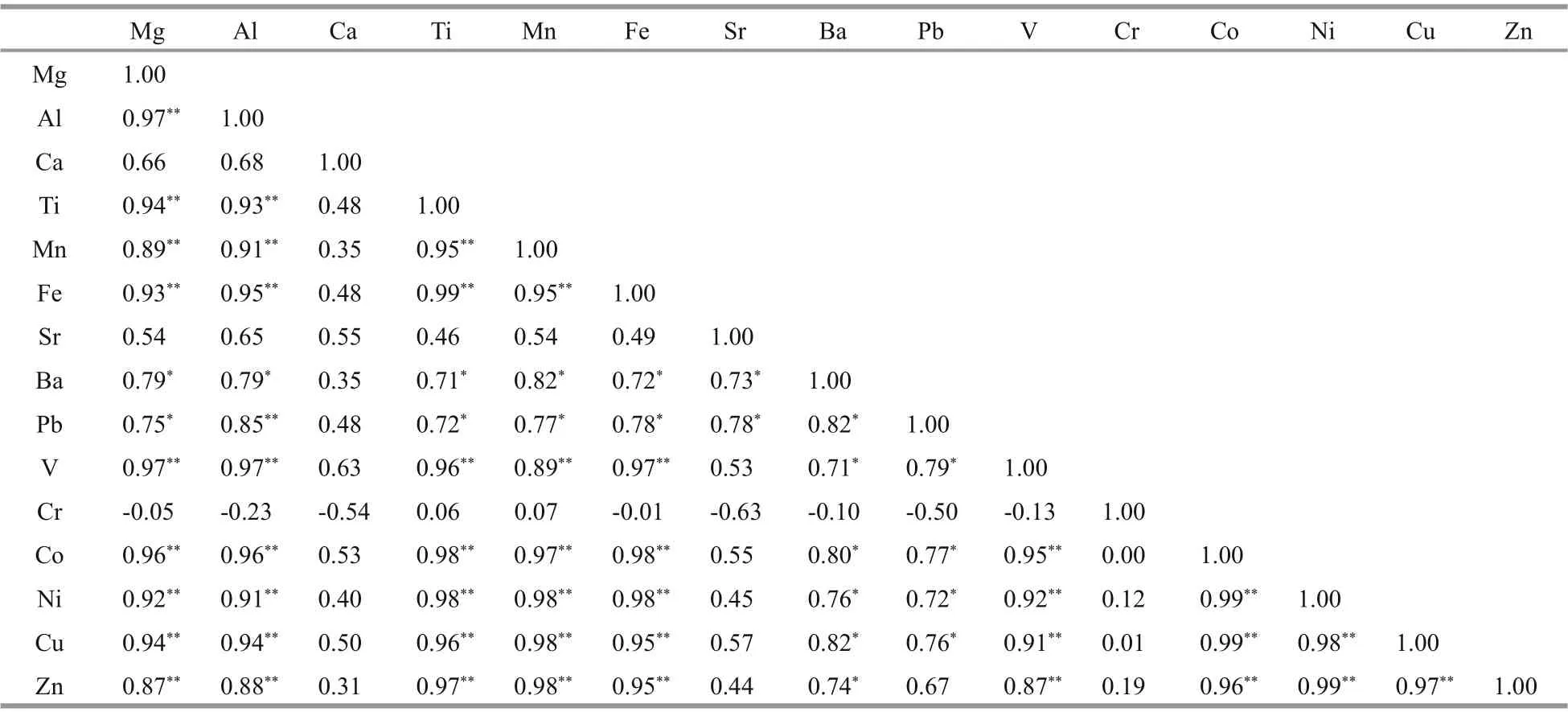
Table 3 Correlations of the concentrations of various elements in the sediment samples from the Dive113 station of the Yap Trench
4.2 The provenances of hadal sediment in the Yap Trench
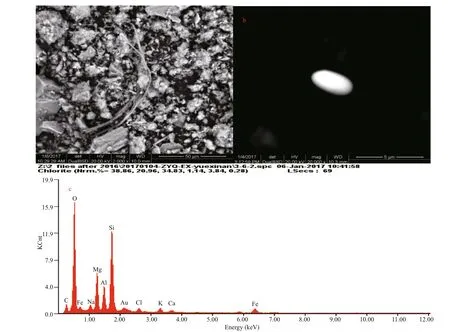
Fig.9 Scanning electron microscope images of sediments from Dive111 (a) and Dive113 (b) stations, and energy dispersive spectrometer images of sediments from Dive111 (c) station in the Yap Trench
The correlation analysis results between the concentrations of any two analyzed elements in the two sediment samples are listed in Tables 3 and 4. In the sediment samples from Dive111 and Dive113 stations, there were signifi cant positive correlations between concentrations of Fe, Mn, Co, Ni, V, Cu, and Zn. The signifi cant positive correlations indicated that these elements might be formed by similar geochemical processes and share same provenances (Li et al., 2007). In addition, almost all these elements were found in manganese nodules. The strong positive correlations of these seven elements in the sediment provide a hint that they might be derived from manganese nodules. The elements (Fe, Mn, Co, Ni, V, Cu and Zn) were considered as typical authigenic components in deep-sea sediments (Thomoson et al., 1984). Their positive correlations showed that marine authigenic source was important for the sediments in the study area. In the sediment from Dive 113 station, signifi cant positive correlations were found between concentrations of Al, Fe, Mg, Mn, Ti, Co, Cu, Ni, Zn, and V. The element Ti in marine sediments mainly comes from aluminosilicate component (Aghadadashi et al. 2019), and the element Al also exists in aluminosilicate clastic minerals. Terrestrial sources are major supply of aluminosilicates component in deep sea sediments (Li et al., 2007). It is reasonable that the sediment in the Yap Trench has terrestrial source. As a comparison, the concentration of Al was negatively correlated with the concentrations of most other elements in the sediment samples from Dive111 station, indicating the sample was much less afference ected by terrestrial material than the sediments from Dive113 station. Garver et al. suggested that the elevated values of Cr (>150×10-6) and Ni (>100×10-6) are signal of existence of ultra-mafi c sources, a kind of volcanic material (Armstrong-Altrin et al., 2015). In Dive111 and Dive113 stations, the average concentration of Cr in the sediment sample was 181×10-6and 102×10-6, respectively; and the average concentration of Ni in the sample was 258×10-6and 166×10-6, respectively; indicating existence of remarkable volcanic source in western side of the trench. Scanning electron microscopy (SEM) image (Fig.9a) and energy dispersive spectrometer (EDS) data of (Fig.9c) showed that typical volcanic rock composition—chrysotile existed in the sediment from Dive111 station, but was rarely found in the sediment from Dive113 station. This difference erence also suggested that the infl uence of volcanic source on the western side of the Yap Trench was more obvious than that on the eastern side. Barium sulfate crystals appeared in the sediment sample of both stations, which mainly comes from hydrothermal and biological sources in oceanic sediments (Wang et al., 2006; Zhou et al., 2011). Generally, barium sulfate formed by hydrothermal is called phanerocrystalline barite, while barium sulfate formed by biological process is called microcrystalline barite (Wang et al., 2006; Zhou et al., 2011). As shown in Fig.9b, barium sulfate in the sediment samples of the trench was 2-3 micron granular crystals, considered as biological origin (Wang et al., 2006; Zhou et al., 2011). These results show that biological source was also important for the sediment in the two stations.

Table 4 Correlations of the concentrations of various elements in the sediment samples from the Dive111 station of the Yap Trench
For further analysis of the provenance of the sediments, the elemental ratio method was applied to investigate the composition of the samples. The ratios of Ti/Al and Fe/Al of the sediment samples at Dive113 and Dive111 stations in the Yap Trench are shown in Table 5. The standard values in the Table 5 were obtained from the Pacifi c abyssal clay (PPC), the Pacifi c tholeiite (ATP), and the Pacifi c benthic turbidity layer (BNL), presenting terrestrial source, volcanic source and biological source, respectively (Li et al., 2007). The vertical variations of the ratios of Ti/Al and Fe/Al with sediment depth are shown in Fig.10a & b. The ratio of Ti/Al equaling to 0.06, 0.10, and 0.12 represents terrestrial source, volcanic source and biological source, respectively (Bischofference et al., 1979; Li et al., 2007). In Dive111 station, the average ratio of Ti/Al at 0-4 cm sediment layers were 0.15 (0.11-0.21), and at 4-7 cm sediment depth, the values of Ti/Al were 0.09 in all the three layers, which revealed that terrestrial source had less impact than volcanic and biological sources on the sediment in the western side of the trench. The average ratio of Ti/Al in the sediment sample from Dive113 station was 0.07 (0.06-0.07), further indicating that on the eastern side of the trench, the infl uence of terrestrial source was more important than volcanic and biological sources. In addition, the average ratio of Fe/Al was 1.06 in the sediments from Dive111 station, indicating remarkable infl uence of volcanic source and biological sources (the ratio of Fe/Al=0.61 standing terrestrial source, 0.73 standing volcanic source and 1.56 standing biological source (Bischofference et al., 1979; Li et al., 2007)). In Dive113 station, the ratios of Fe/Al in all sediment layers were around 0.9, indicating obvious volcanic impact on the sediment formation. Although there were some difference erences of the provenance analysis on the sediment sample from Dive 113 station based on the ratios of Ti/Al and Fe/Al, attributing to similar impact of terrestrial source and volcanic source on the sample, both ratios indicated that biological source had minimal impact on the sediment. In the Yap Trench, although its eastern side is farther from land than the western side, it was afference ected by terrestrial source more signifi cantly. It might be attribute to an asymmetric “V” shaped structure of the trench in which ocean-ward slop is gentle but land-ward slope is steeper (Yang et al., 2017). Therefore, the steeper slop blocks the input of terrestrial source to the western side. The island arc on the western side of the trench also becomes a barrier for terrestrial material deposition (Yang et al., 2017). On the other side, recently study showed the existence of geostrophic circulation in the Yap Trench (Liu et al., 2018). Even if the terrestrial materials deposited in the western side of the trench, the movement of geostrophic circulation could transport various materials from its western side to the eastern side, further strengthening the impact of terrestrial source on the sediment in the eastern side. Previous study also showed that the trench had a high heat fl ow value and frequent micro-earthquakes (Song et al., 2016), and small-scale hydrothermal activity might exist in its western side. Therefore, it is reasonable that the volcanic activity had a more signifi cant impact on the western side of the trench. In addition, volcanic materials in the trench might come from the nearby Mariana Volcanic Arc. It has reported that the volcanic material from arc could fl ow into the northern Parisivilla Basin (Ming, 2013). More research is still needed to verify if the materials from the Mariana Volcanic Arc can enter the Yap Trench.
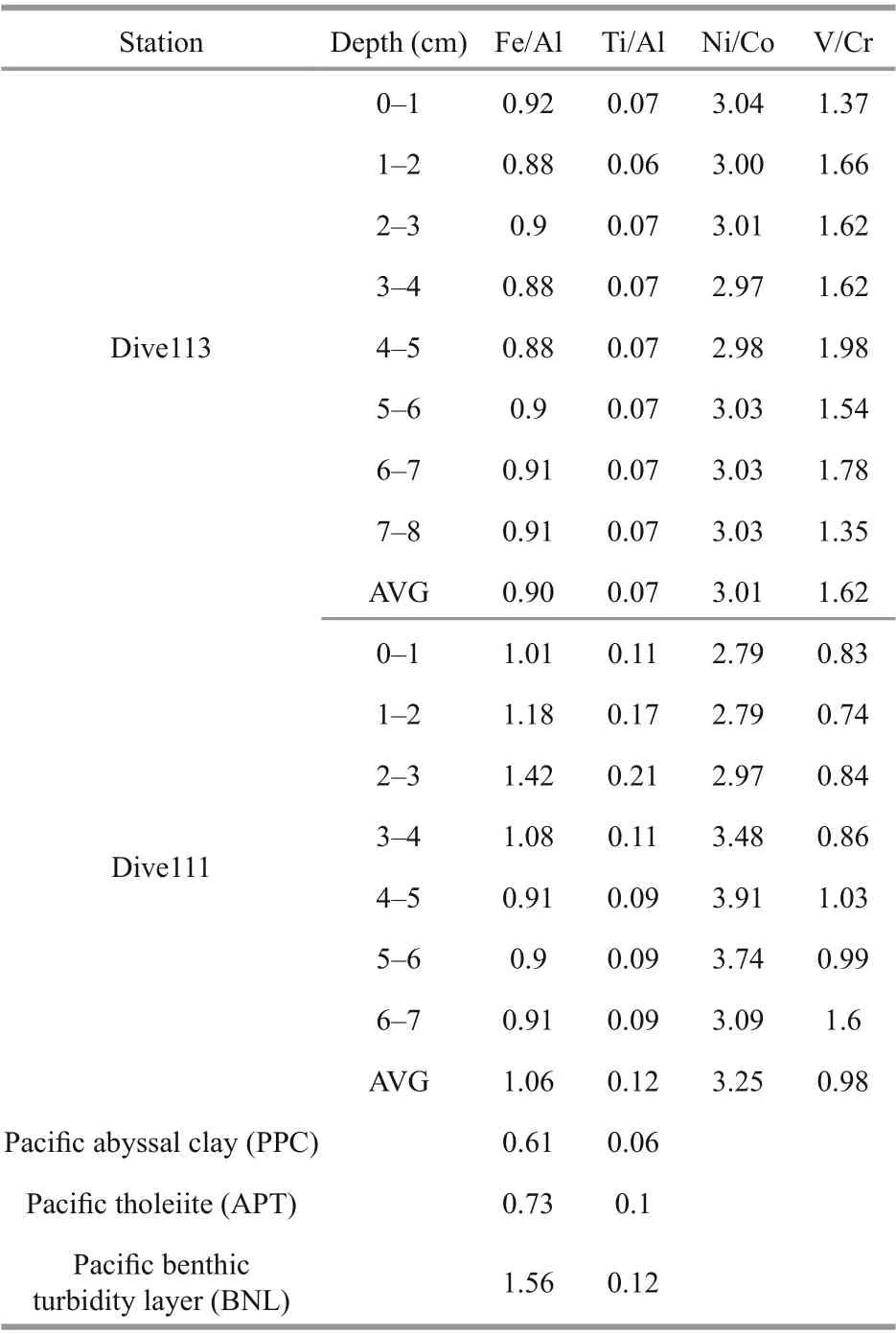
Table 5 The ratios of some elements in the two sediment samples from the Yap Trench
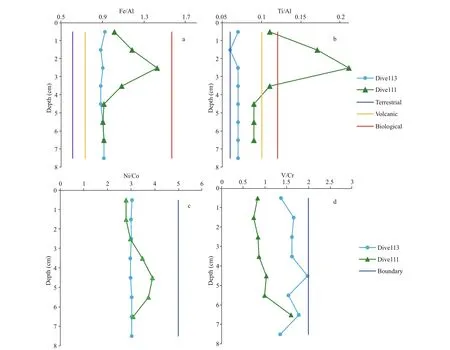
Fig.10 Vertical variation profi les of the ratios of Fe/Al, Ti/Al, Ni/Co and V/Cr in two sediment samples from the Yap Trench
In summary, our data indicated that the hadal sediment in the Yap Trench had terrestrial, volcanic, authigenic, and biological sources. In the eastern side of the trench, the major source of the sediment was terrestrial. In the western side of the trench, the sediments were afference ected by volcanic activity more signifi cantly. The difference erence of sediment provenances between the two sides might be related to the special geographic structure and surrounding environment of the trench.
4.3 Depositional environment of the hadal zone in the Yap Trench
The elemental composition of the sediment samples in the Yap Trench refl ects the redox characteristics of the sedimentary environment in a certain extent. The redox state of ocean water is closely related to geological phenomena such as ocean hypoxia, ocean circulation, life explosion, and biological extinction. The sediment processes of trace elements are controlled by many biological and abiotic factors. In marine environment, a typical biological process is zooplankton (phytoplankton) feeding on the elements Fe, Ba, Cu, Zn, etc. The migration of trace elements along the redox gradient of sediment is an important abiotic process, which could promote partial enrichment of some specifi c elements. In seawater, difference erent redox condition caused various enrichment level of difference erent elements (Ramos-Vazquez et al., 2017). Therefore, tracking the ratio of trace elements provides a way to reconstruct the redox conditions of ancient sediments. Previous studies often applied Ni/Co=5 and V/Cr=2 as the boundary to distinguish oxidative environment and reducing environment (Ramos-Vazquez et al., 2018), If the ratio lower than the values, the environment is oxidative, otherwise, the environment is reducing. The results of Table 5 and Fig.10c & d showed that the ratio of Ni/Co in all depths of the two sediment samples were lower than 5, and the ratio of V/Cr were lower than 2. Therefore, the sedimentary environment in northern of the Yap Trench was oxidative. Previous studies have also shown that the bottom of the Parisivira Basin located in the north of the Yap Trench had infl ow of the Antarctic bottom oxygen-rich water (Ming, 2013), and the Yap Trench also had infl ow of the Antarctic bottom oxygen-rich water (Johnson and Toole, 1993). Recent research also showed that the potential temperature ranged from 1 to 1.5°C, salinity ranging from 34.66 to 34.70, potential density ranged from 27.77 to 27.81 σ0kg/m3and the dissolved oxygen concentration increases to 3.6 mg/L in the deep water of the study area (Liu et al., 2018). The channel connecting the ECB (East Caroline Basin) to the Yap Trench presented similar profi les in the following ways: dissolved oxygen concentration >3.4 mg/L, potential temperature <1.2°C and salinity >34.68 at the depth range from 4 000 m to the bottom. The similar water properties might suggest that the deepwater mass in the Yap Trench originates from the EMB (East Mariana Basin) and ECB, as a part of the Lower Circumpolar Deep Water LCPW) (Liu et al., 2018). It is reasonable that the oxygen-rich water promoted the formation of the oxidative environment of the trench. Our results also indicated that the hadal zone in the Yap Trench was likely to be oxidized for a long time, resulting in lower ratio of V/Cr and Ni/Co in the sediment samples.
5 CONCLUSION
The sediment samples on the eastern side of the Yap Trench were siliceous mud, mainly composed of diatoms, radiolarian, and sponge needles from surface to deep sediment layers. The water content, total organic carbon content and the concentrations of all elements in the sediment samples on the eastern side of the Yap Trench were stable with sediment depth, attribute to the bottom current motion. Difference erent current motions might cause strongly mixing of all the components during accumulation of sediments, resulting in consistency of concentrations of all components from surface sediment to deep layer.
According to the ratios of Ti/Al and Fe/Al, the correlation of elemental concentrations and the morphological characteristics of the sediment, the sediment in the hadal zone of the Yap Trench had terrestrial, volcanic, authigenic and biological sources. Major provenance of the sediment in the eastern side of the trench was terrestrial, and the sediment in the western side of the trench was signifi cantly afference ected by volcanic activity.
The sedimentary environment of the hadal zone in the Yap Trench was oxidative, possibly ascribing to infl ow of the Antarctic bottom oxygen-rich water.
6 DATA AVAILABILITY STATEMENT
The datasets generated during the current study are available from the corresponding author on reasonable request.
References
Aghadadashi V, Neyestani M R, Mehdinia A, Bakhtiari A R, Molaei S, Farhangi M, Esmaili M, Marnani H R, Gerivani H. 2019. Spatial distribution and vertical profi le of heavy metals in marine sediments around Iran’s special economic energy zone; Arsenic as an enriched contaminant. Marine Pollution Bulletin, 138: 437-450, https://doi.org/10.1016/j.marpolbul.2018.11.033.
Armstrong-Altrin J S, Machain-Castillo M L, Rosales-Hoz L, Carranza-Edwards S, Sanchez-Cabeza J A. Ruíz-Fernández A C. 2015. Provenance and depositional history of continental slope sediments in the Southwestern Gulf of Mexico unraveled by geochemical analysis. Continental Shelf Research, 95: 15-26, https://doi.org/10.1016/j.csr.2015.01.003.
Bischofference J L, Heath G R, Leinen M. 1979. Geochemistry of deep-sea sediments from the Pacifi c manganese nodule province: DOMES Sites A, B, and C. In: Bischofference J L, Piper D Z eds. Marine Geology and Oceanography of the Pacifi c Manganese Nodule Province. Springer, Boston, MA. p.397-436, https://doi.org/10.1007/978-1-4684-3518-4_12.
Dubois N, Mitchell N C. 2012. Large-scale sediment redistribution on the equatorial Pacifi c seafl oor. Deep Sea Research Part I: Oceanographic Research Papers, 69: 51-61, https://doi.org/10.1016/j.dsr.2012.07.006.
Fujiwara T, Tamura C, Nishizawa A, Fujioka K, Kobayashi K, Iwabuchi Y. 2000. Morphology and tectonics of the Yap Trench. Marine Geophysical Researches, 21(1-2): 69-86, https://doi.org/10.1023/A:1004781927661.
Glud R N, Wenzhfer F, Middelboe M, Oguri K, Turnewitsch R, Canfi eld D E, Kitazato H. 2013. High rates of microbial carbon turnover in sediments in the deepest oceanic trench on Earth. Nature Geoscience, 6(4): 284-288, https://doi.org/10.1038/NGEO1773.
Hawkins J, Batiza R. 1977. Metamorphic rocks of the Yap arctrench system. Earth and Planetary Science Letters, 37(2): 216-229, https://doi.org/10.1016/0012-821X(77)90166-2
Hettipathirana T, Lowenstern P. 2015. Determination of major and minor elements contained in geological samples by microwave plasma-atomic emission spectrometer (MPAES). Chinese Journal of Inorganic Analytical Chemistry, 5(1): 41-44, https://doi.org/10.3969/j.issn.2095-1035.2015.01.012. (in Chinese with English abstract)
Jamieson A J, Fujii T, Mayor D, Solan M, Priede I G. 2010. Hadal trenches: the ecology of the deepest places on Earth. Trends in Ecology & Evolution, 25(3): 190-197, https://doi.org/10.1016/j.tree.2009.09.009.
Jamieson A J. 2011. Ecology of deep oceans: hadal trenches. eLS, https:// dx.doi.org/10.1002/9780470015902.a0023606.
Johnson G C, Toole J M. 1993. Flow of deep and bottom waters in the Pacifi c at 10°N. Deep Sea Research Part I: Oceanographic Research Papers, 40(2): 371-394, http://doi.org/10.1016/0967-0637(93)90009-R.
Juan C, Van Rooij D, De Bruycker W. 2018. An assessment of bottom current controlled sedimentation in Pacifi c Ocean abyssal environments. Marine Geology, 403: 20-33, https://doi.org/10.1016/j.margeo.2018.05.001.
Li G S, Yang R, Zhang H R. 2007. Geochemistry and sedimentary environments of the quaternary sediments in the mid-Pacifi c Ocean. Sedimentary Geology and Tethyan Geology, 27(3): 33-43. (in Chinese with English abstract)
Liu Y Z, Liu X H, Lv X Q, Cao W, Sun C J, Lu J, Wang C S, Lu B, Yang J C. 2018. Watermass properties and deep currents in the northern Yap Trench observed by the Submersible Jiaolong system. Deep Sea Research Part I: Oceanographic Research Papers, 139: 27-42, https://doi.org/10.1016/j.dsr.2018.06.001.
Luo M, Algeo T J, Chen L Y, Shi X F, Chen D F. 2018a. Role of dust fl uxes in stimulating Ethmodiscus rex giant diatom blooms in the northwestern tropical Pacifi c during the Last Glacial Maximum. Palaeogeography, Palaeoclimatology, Palaeoecology, 511: 319-331, https://doi.org/10.1016/j.palaeo.2018.08.017.
Luo M, Algeo T J, Tong H P, Gieskes J, Chen L Y, Shi X F, Chen D F. 2018b. More reducing bottom-water redox conditions during the Last Glacial Maximum in the southern Challenger Deep (Mariana Trench, western Pacifi c) driven by enhanced productivity. Deep Sea Research Part II: Topical Studies in Oceanography, 155: 70-82. https://doi.org/10.1016/j.dsr2.2017.01.006.
Luo M, Gieskes J, Chen L Y, Shi X F, Chen D F. 2017. Provenances, distribution, and accumulation of organic matter in the southern Mariana Trench rim and slope: Implication for carbon cycle and burial in hadal trenches. Marine Geology, 386: 98-106, https://doi.org/10.1016/j.margeo.2017.02.012.
Luo M, Glud R N, Pan B B, Wenzhöfer F, Xu Y P, Lin G, Chen D F. 2018c. Benthic carbon mineralization in hadal trenches: insights from in situ determination of benthic oxygen consumption. Geophysical Research Letters, 45(6): 2 752-2 760. https://doi.org/10.1002/2017GL076232.
Ming J. 2013. The characteristics and provenance of the sediment in the Parece Vela Basin since the quaternary and their environmental implications. Institute of Oceanology, Chinese Academy of Sciences, Qingdao, China. 127p. (in Chinese with English abstract)
Paull C K, Talling P J, Maier K L, et al. 2018. Powerful turbidity currents driven by dense basal layers. Nature Communications, 9: 4 114, http://doi.org/10.1038/s41467-018-06254-6.
Peng Y J, Wang Y J, Liu D Y, Tang D L. 2015. Acid treatment efference ects on the carbon stable isotope values of marine sediments. Acta Oceanologica Sinica, 37(12): 85-92, http://doi.org/10.3969/j.issn.0253-4193.2015.12.009. (in Chinese with English abstract)
Ramos-Vázquez M A, Armstrong-Altrin J S, Machain-Castillo M L, Gío-Argáez F R. 2018. Foraminiferal assemblages,14C ages, and compositional variations in two sediment cores in the western Gulf of Mexico. Journal of South American Earth Sciences, 88: 480-496, https://doi.org/10.1016/j.jsames.2018.08.025.
Ramos-Vázquez M A, Armstrong-Altrin J S, Rosales-Hoz L, Machain-Castillo M L, Carranza-Edwards A. 2017. Geochemistry of deep-sea sediments in two cores retrieved at the mouth of the Coatzacoalcos River delta, western Gulf of Mexico, Mexico. Arabian Journal of Geosciences, 10: 148, https://doi.org/10.1007/s12517-017-2934-z.
Song Y D, Ma X C, Zhang G X, Liu X S, Luan Z D, Dong D D, Yan J. 2016. Heat fl ow in-situ measurement at Yap Trench of the western pacifi c. Marine Geology & Quaternary Geology, 36(4): 51-56, https://doi.org/10.16562/j.cnki.0256-1492.2016.04.006. (in Chinese with English abstract)
Thomoson J, Carpenter M S N, Colly S, Wilson T R S, Elderfi eld H, Kennedy H. 1984. Metal accumulation rates in northwest Atlantic pelagic sediments. Geochimica et Cosmochimica Acta, 48(10): 1 935-1 948, https://doi.org/10.1016/0016-7037(84)90376-4.
Turnewitsch R, Falahat S, Stehlikova J, Oguri K, Glud R N, Middelboe M, Kitazato H, Wenzhöfer F, Ando K, Fujio S, Yanagimoto D. 2014. Recent sediment dynamics in hadal trenches: evidence for the infl uence of higher-frequency (tidal, near-inertial) fl uid dynamics. Deep Sea Research Part I: Oceanographic Research Papers, 90: 125-138, https://doi.org/10.1016/j.dsr.2014.05.005.
Wang D Y, Lu X C, Xu S J, Yang J D. 2006. Application of abyssal benthic barite to paleoceanographic studies. Marine Geology & Quaternary Geology, 26(4): 67-71, https://doi.org/10.16562/j.cnki.0256-1492.2006.04.010. (in Chinese with English abstract)
Watling L, Guinotte J, Clark M R, Smith C R. 2013. A proposed biogeography of the deep ocean fl oor. Progress in Oceanography, 111: 91-112, https://doi.org/10.1016/j.pocean.2012.11.003.
Wenzhöfer F, Oguri K, Middelboe M, Turnewitsch R, Toyofuku T, Kitazato H, Glud R N. 2016. Benthic carbon mineralization in hadal trenches: Assessment by in situ O2microprofi le measurements. Deep Sea Research Part I: Oceanographic Research Papers, 116: 276-286, https://doi.org/10.1016/j.dsr.2016.08.013.
Xiong Z F, Li T G, Algeo T, Doering K, Frank M, Brzezinski M A, Chang F M, Opfergelt S, Crosta X, Jiang F Q, Wan S M, Zhai B. 2015. The silicon isotope composition of Ethmodiscus rex laminated diatom mats from the tropical West Pacifi c: implications for silicate cycling during the Last Glacial Maximum. Paleoceanography and Paleoclimatology, 30(7): 803-823, https://doi.org/10. 1002/2015PA002793.
Yang Y M, Wu S G, Gao J W, et al. 2017. Geology of the Yap Trench: new observations from a transect near 10°N from manned submersible Jiaolong. International Geology Review, 60(16): 1 941-1 953, https://doi.org/10.1080/002 06814.2017.1394226.
Zhang X X, Xu W, Liu Y, Cai M W, Luo Z H, Li M. 2018. Metagenomics reveals microbial diversity and metabolic potentials of seawater and surface sediment from a hadal biosphere at the Yap Trench. Frontiers in Microbiology, 9: 2 402, https://doi.org/10.3389/fmicb.2018.02402.
Zhou C, Jin H Y, Jian Z M. 2011. Variations of the late quaternary Paleo-productivity in the western equatorial Pacifi c: evidences from the elemental ratios. Quaternary Sciences, 31(2): 276-283, https://doi.org/10.3969/j.issn.1001-7410.2011.02.09. (in Chinese with English abstract)
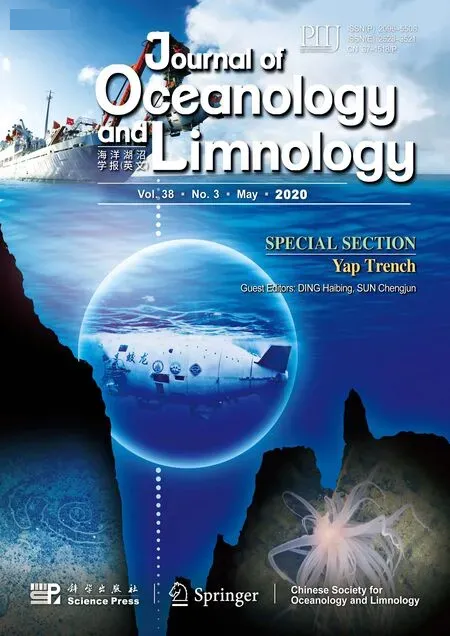 Journal of Oceanology and Limnology2020年3期
Journal of Oceanology and Limnology2020年3期
- Journal of Oceanology and Limnology的其它文章
- List of the Most Outstanding Papers Published by CJOL/JOL in 2017-2018
- Who is the “murderer” of the bloom in coastal waters of Fujian, China, in 2019?*
- The investigation of internal solitary waves over a continental shelf-slope*
- Efference ect of diets on the feeding behavior and physiological properties of suspension-feeding sea cucumber Cucumaria frondosa*
- Efference ects of light quality on growth rates and pigments of Chaetoceros gracilis (Bacillariophyceae)*
- Marine bacterial surfactin CS30-2 induced necrosis-like cell death in Huh7.5 liver cancer cells*
